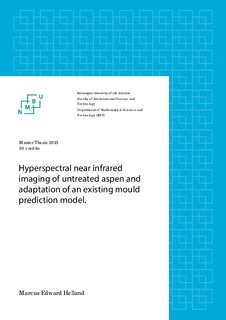Hyperspectral near infrared imaging of untreated aspen and adaptation of an existing mould prediction model
Master thesis
Permanent lenke
http://hdl.handle.net/11250/295818Utgivelsesdato
2015-08-10Metadata
Vis full innførselSamlinger
- Master's theses (RealTek) [1722]
Sammendrag
Wood as a building material is beneficial for the environment; it stores CO2 and saves CO2 emissions from other materials. Prediction models of mould growth are necessary to estimate the service life of wood. To make accurate models, accurate assessments are needed. Todays standard of visual assessment has some weaknesses, with different rating scales which can be difficult to compare and a subjective rating. Hyperspectral imaging may provide objective and accurate mould assessments for use in more accurate mould growth models.
Untreated wood samples were sprayed with a mould culture before exposed to eight different transient climates in a laboratory. Weekly measurements of mould growth was assessed by hyperspectral imaging and by visual method EN 927-3. Partial least squares discriminant analysis (PLS-DA) was used to differentiate and predict mould growth on samples. Mould growth intensity factor of aspen, with the empirical mould growth model by Viitanen and Hakku, was estimated and compared with measured mould growth.
Hyperspectral imaging consequently showed less mould than visual assessment. There was a large variation in mould growth on aspen under equal climate conditions. The growth intensity factor, k1, for aspen in 25C, 85% relative humidity and 2 hours daily light showers, was calculated to k1 = 10 ± 10 for mould index larger than 1 and k1 = 0,9 ± 0,2 for mould index less than 1.
Hyperspectral images contain differences, in the spectral bands from 900nm to 1700nm, between untreated aspen and mould. This can be used to measure amount of mould on an untreated aspen cladding.
